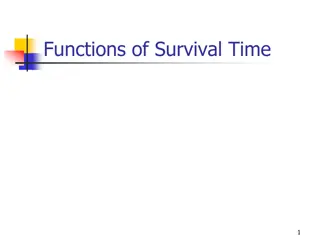Introduction to Survival Analysis in Epidemiological Research
In epidemiology, survival analysis is used to analyze time-to-event outcomes like time until death or disease occurrence. It evaluates the effect of treatments on outcomes and considers both event occurrence and timing. This involves various methods such as the Kaplan-Meier estimator, hazard analysis, and parametric survival models like the Cox proportional hazards model. R offers a range of packages for conducting survival analysis.
Download Presentation

Please find below an Image/Link to download the presentation.
The content on the website is provided AS IS for your information and personal use only. It may not be sold, licensed, or shared on other websites without obtaining consent from the author.If you encounter any issues during the download, it is possible that the publisher has removed the file from their server.
You are allowed to download the files provided on this website for personal or commercial use, subject to the condition that they are used lawfully. All files are the property of their respective owners.
The content on the website is provided AS IS for your information and personal use only. It may not be sold, licensed, or shared on other websites without obtaining consent from the author.
E N D
Presentation Transcript
Survival Analysis Survival Analysis EPID 799C, Lecture 22 Wednesday, Nov. 14, 2018
Acknowledgements Acknowledgements Brian Pence (EPID 718) Alan Brookhart and Steve Cole (EPID 722) Mike and Nick!
Intro to Survival Analysis Intro to Survival Analysis Epidemiological methods to analyze time-to-event outcomes: Time until death (a.k.a., survival) Time until disease occurrence Time until treatment initiation or discontinuation Evaluate effect of treatment on the outcome both occurrence and timing of the event of interest.
Intro to Survival Analysis Intro to Survival Analysis Single ascertainment of presence/absence of the outcome: Outcome Treatment vs. Measure outcomes over time: Treatment A=1 Treatment A=0 Outcome Follow-up time (t) for
Survival Methods Survival Methods Survival at time t: Probability of event-free survival up to time t. This is the complement of the cumulative risk of the event. Cumulative risk at time t: Risk(t) = 1 Survival(t) Hazard at time t: Instantaneous rate of events. Conditional probability of the event at time t, given survival to time t. Survival Analysis spreadsheet found on my computer
Survival Methods Survival Methods Kaplan-Meier is a non-parametric estimator of survival. Defined as the cumulative product of the estimated probability of not incurring an event. Other non-parametric estimators: Nelson-Aalen (cumulative hazard), Aalen- Johansen (competing events). Parametric survival methods assume the underlying distribution of the survival times follows a known probability distribution. Exponential, Weibull, lognormal, etc. Cox proportional hazards model is a semiparametric approach, used to estimate the relationship between the hazard function and predictor variables.
Survival Analysis in R Survival Analysis in R Lots of package options! Here are a few: Core survival analysis methods: survival (most other packages rely on it) Survival plots: ggfortify and survminer Tidy your Cox models: survutils Dealing with competing risks: cmprsk Alan Brookhart s work in progress: ipwrisk Many more here: https://cran.r-project.org/web/views/Survival.html
Births Example Births Example Preterm birth as a time-to-event outcome. Time to event: wksgest Event status: preterm Risk period: 20-36 weeks of gestation
Censoring and Competing Events Censoring and Competing Events Survival methods need to account for censoring and competing events in analyzing time-to-event data. In addition to confounding and the usual suspects.
Censoring and Competing Events Censoring and Competing Events Censoring events (e.g., study drop-out) prevent our observation of the outcome. Censoring event Outcome Treatment
Censoring and Competing Events Censoring and Competing Events Censoring events (e.g., study drop-out) prevent our observation of the outcome. Determinants Censoring event Outcome Treatment Informative censoring occurs when there are determinants of both censoring and the outcome. If not dealt with analytically, can bias risk estimates.
Censoring and Competing Events Censoring and Competing Events Competing events (e.g., death) prevent the occurrence of the outcome. X Treatment Outcome Competing event
Censoring and Competing Events Censoring and Competing Events Competing events (e.g., death) prevent the occurrence of the outcome. X Treatment Outcome Competing event Outcome Treating competing events like censoring events (i.e., assuming outcome could later occur) can bias our estimates of risk.
IP Weights for Survival Analysis IP Weights for Survival Analysis Confounding: Apply IPTW to survival data (same approach from Monday). Censoring: Account for potentially informative censoring by applying IPCW. Competing risks: Use an IP-weighted estimator that allows for multiple event types.
WIHS Example WIHS Example Data from the Women s Interagency HIV Study on history of injection drug use (exposure) and incidence of treatment initiation (outcome). See Lau 2009 AJE for survival methods using this data. With similar data: Cole 2015 AJE (theory), Cole 2015 AJE (application)
WIHS Example WIHS Example 1,164 patients with HIV, free of clinical AIDS Dec. 6, 1995 FDA approval Dec. 6, 2005 End of study 10-year follow-up
WIHS Example WIHS Example 1,164 patients with HIV, free of clinical AIDS Dec. 6, 1995 FDA approval Dec. 6, 2005 End of study 10-year follow-up Outcome event
WIHS Example WIHS Example 1,164 patients with HIV, free of clinical AIDS Dec. 6, 1995 FDA approval Dec. 6, 2005 End of study 10-year follow-up Outcome event Censoring event
WIHS Example WIHS Example 1,164 patients with HIV, free of clinical AIDS Dec. 6, 1995 FDA approval Dec. 6, 2005 End of study 10-year follow-up Outcome event Censoring event Competing event
Access the WIHS Data Access the WIHS Data library(devtools) devtools::install_bitbucket("novisci/wihs2009") library(WIHS2009) #more info here: https://bitbucket.org/novisci/wihs2009/src/master/























